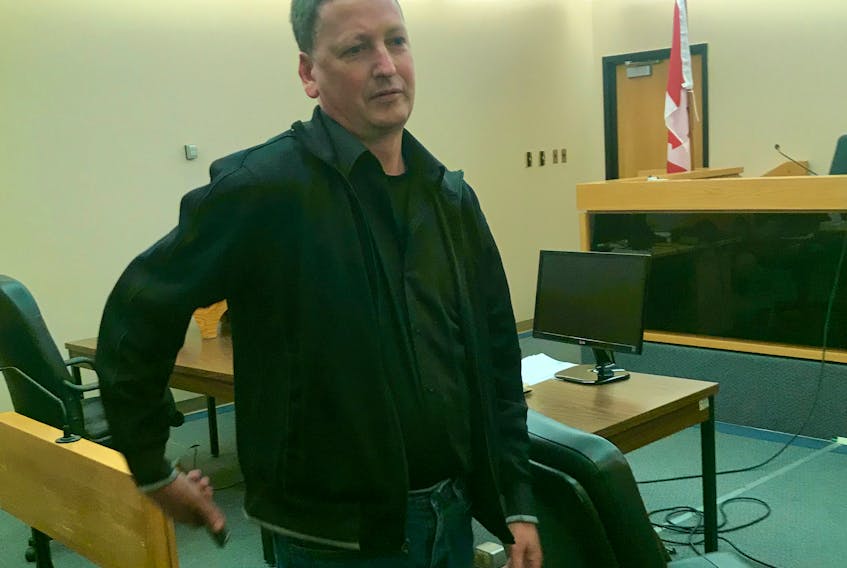Prosecutor Paul Thistle’s cross-examination of an ex-Mountie testifying for the defence in a child pornography case was over almost as quickly as it had started Friday.
Scott Frankland, a former RCMP officer specializing in computer forensics and Internet crimes, spent a day and a half on the witness stand at the trial of Thomas O’Grady this week. O’Grady has pleaded not guilty to charges of possessing and distributing child pornography and Frankland is working for O’Grady’s defence lawyer, using his expertise in investigating child pornography crimes to help build a case for O’Grady’s acquittal.
Testifying as an expert witness, Frankland has been tearing apart the police investigation that resulted in O’Grady’s charges, telling the court there were significant errors made and evidence omitted.
O’Grady, 53, was charged after police received information about a local IP address (a specific computer identification number) being involved in accessing child pornography online. A search warrant was executed on the Kilbride home he shares with four family members, and police located hundreds of examples of child pornography on a desktop computer and a portable hard drive from the basement family room, as well as a jump drive from O’Grady’s bedroom.
Frankland has criticized the handling of evidence by the police and civilian tech experts on the investigative team, the seizure of items, the review of the evidence and more, focusing most of his testimony on a lengthy report on the evidence completed by one of the civilian experts. Frankland said he believed, after reviewing that report alone, that there was no evidence to determine any of the devices seized by police were responsible for uploading images of child pornography on one of the dates alleged. The report was missing significant information to allow for a proper review of much of the evidence, he testified.
On Friday, Frankland said his own investigation of the evidence in the report had turned up three phone numbers he believes could be associated with people in the United States who may be involved in child pornography crimes.
Without the information missing from the report, he said, he was not able to determine how the numbers were connected to O’Grady’s devices.
“There is some pretty significant investigative work that wasn’t done. I see some very significant evidentiary gaps,” Frankland told the court, adding he planned to turn the phone numbers over to the RCMP after the trial was over.
“I do not believe that either of Mr. O’Grady’s devices were used to compile this information,” he said.
Frankland also said he had found an instance where two devices seized from O’Grady’s home — the desktop computer and an iPad — had shown identical log-in dates and times on a banking website. He said this could happen if the devices had been synced through one Google account.
“If you sold a device or gave it to a family members to use and you didn’t properly wipe it first, their activity would show up (on your device), too,” he testified.
Asked by defence lawyer Rosellen Sullivan for a summary of his conclusions, Frankland said though he couldn’t confirm it based on the information in the report, he believed another unknown device which had not been seized by police had been used to access the child pornography found on the items located in O’Grady’s home.
Thistle was quick to speak when it was his turn to question Frankland, asking him to confirm whether the jump drive could be plugged into a write-blocker — a device used to protect the information on a drive from damage or alterations — and the contents then viewed.
“You can plug in a write-blocker and you can see what’s on a device without altering it in any way, right? That’s commonly done and it’s forensically valid and it doesn’t damage the exhibit in any way?,” Thistle asked.
“That’s correct,” Frankland replied.
“So if I get the police to bring down a write-blocker and plug it in to that computer, we could open up (the jump drive) and see what’s on there and confirm what’s there? We’ll do that,” Thistle said, telling Judge Lori Marshall he planned to close the courtroom for that evidence when the trial resumed after lunch.
When that time came, however, Sullivan objected to the jump drive being opened for the court, saying she nor the lawyers she had consulted over the break had never experienced that in a child pornography case before.
O’Grady’s trial was adjourned until next week, when Marshall will hear arguments from Sullivan and Thistle regarding the viewing of the evidence in court.
Twitter: @tara_bradbury
RELATED:









